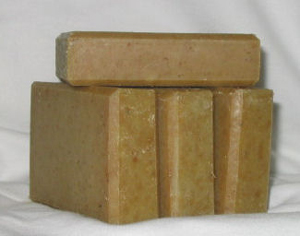How to Make
Soap From Biodiesel!
Search this site!
Have you wondered what to do with your
biodiesel waste
left over from processing? One option is to make soap from biodiesel glycerol by-product.

Ingredients For Soap Making:
• Glycerol by-product from biodiesel production
• Water
• Sodium Hydroxide (Lye) or Potassium Hydroxide (Potash) (which ever was used as the catalyst during transesterification).
Photo courtesy of Madaise
They can be purchased online from Duda. The Sodium Hydroxide will make hard soap, the Potash will make liquid soap.
• Pitcher or beaker large enough to hold water and lye
• Molds (Tupperware or Rubbermaid containers, ice cream cartons, Jell-O/candy molds, cardboard flats.) Do not use anything made from aluminum, tin, or zinc because lye will corrode it.
• Old pot or a slow cooker to heat mixture in (steel would work well)
• Wooden spoon
• 2 thermometers that will clip on
• Essential oil or fragrance oil (optional)
• Dried flowers or herbal powder for adding texture and interest to your soap from biodiesel (optional)
Safety First!
* Work in a well-ventilated room or out doors. If working in the kitchen, use an exhaust hood.
* Wear rubber gloves, splash protection goggles, long sleeve shirt and pants, closed-toe shoes.
* Any pots, molds, stirring utensils, or ANYTHING that is used in this process should not be used for any other purpose once after you have used it to make soap from biodiesel.
* If your skin comes in contact with the lye, rinse it with vinegar, then wash with soap and water.
A General Overview of the Soap From Biodiesel Process:
• Remove any methanol from the glycerol BEFORE starting the process of making soap from biodiesel. (
Click here to learn how to recover methanol
).
• Put on your safety gear and cover the work area!
• Heat the glycerin until runny, set aside
• Measure the cold water and place it in the pitcher or beaker.
• Measure the lye/potash and add it to the water. Stir it until it is dissolved. (This mixture will heat up without your help.)
• Attach a thermometer to the pitcher of water/lye and monitor it as it cools.
• Slowly add the water/lye mixture to the glycerin by pouring in a slow constant stream while stirring slowly and steadily with a wooden spoon. Leave the heat on while continuing to mix it for 15-20 minutes.
• Check to see if it is ready by tracing the spoon through the mixture, if the line stays for a few seconds it is ready. If not, re-check every 15 minutes.
• Add any fragrances or herbs, and stir them in.
• Pour the mixture into a mold or container to the desired thickness and place something over the top of the container to slow the cooling process. (Soap cooled too quickly may separate). Do not scrape the sides of the pot unless you are certain they have been thoroughly mixed.
• In 24 hours check to see if the soap is set. If your finger leaves an indention it is not set. If set, uncover and allow to dry uncovered for another 24 hours.
• Carefully loosen around the edges and turn the container upside down onto wax paper. Lightly tap on the bottom of the container to release the soap. If it does not release easily, allow it to set longer.
• If the soap needs to be cut into smaller bars use a heated paring knife to cut, and a ruler as a straight edge guideline. You may also use a thin wire wrapped around two dowel rods by using the wire to saw back and forth through the soap and the dowels as handles.
• Allow the bars to dry for another week or two before testing it. The soap will lighten in color as it dries and may sweat (this is normal). If the soap is hard to the touch, try washing your hands with a bar. If it stings there is still lye present and it needs to cure longer.
• Store the soap with wax paper in between the layers to prevent it from sticking together.
When you feel ready to try your first batch, here is
Graham Laming's recipe for biodiesel soap.
Tips:
• Add the lye to very cold water to avoid boiling.
• Using more water in the soap will give it more of a lather.
• Using more lye when making soap will make it a better degreaser but will also dry out the hands more.
• Cover work area to avoid stains from the lye/potash.
• The lye mixture and the glycerol should be within 5°F of each other when mixed together.
• If the ‘trace test’ is not met the soap may separate into layers.
• If using potash, multiply the amount of lye called for by 1.4 and substitute.
• Making soap from biodiesel made from WVO will produce differing hardness of soaps. This is caused from the varying fats/oils found in WVO.
Return from 'Make soap from Biodiesel' to 'Making Biodiesel Fuel'
Biodiesel Homepage